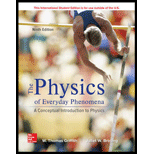
Concept explainers
A cannon is fired over level ground at an angle of 35° to the horizontal. The initial velocity of the cannonball is 500 m/s, but because the cannon is fired at an angle, the vertical component of the velocity is 287 m/s and the horizontal component is 410 m/s.
- a. How long is the cannonball in the air? (Use g = 10 m/s2 and the fact that the total time of flight is twice the time required to reach the high point.)
- b. How far does the cannonball travel horizontally?
- c. Repeat these calculations, assuming that the cannon was fired at a 55° angle to the horizontal, resulting in a vertical component of velocity of 410 m/s and a horizontal component of 287 m/s. How does the distance traveled compare to the earlier result? (See fig. 3.20.)
(a)
The time of flight of the ball.
Answer to Problem 4SP
The time of flight of the ball is
Explanation of Solution
Given Info: A cannon is fired over the ground level at an angle of
Write the expression for the time required to reach the high point.
Here,
Substitute
Write the expression for the time of flight.
Here,
Substitute
Conclusion:
Thus, the time of flight of the ball is
(b)
The distance travelled by the cannonball horizontally.
Answer to Problem 4SP
The distance travelled by the cannonball horizontally is
Explanation of Solution
Given Info: A cannon is fired over the ground level at an angle of
Write the expression for the distance travelled horizontally.
Here,
Substitute
Conclusion:
Thus, the distance travelled by the cannonball horizontally is
(c)
Repeat the above results for angle
Answer to Problem 4SP
The time of flight of the ball is
Explanation of Solution
Given Info: A cannon is fired over the ground level at an angle of
Write the expression for the time required to reach the high point.
Substitute
Write the expression for the time of flight.
Substitute
Write the expression for the distance travelled horizontally.
Substitute
Conclusion:
Thus, the time of flight of the ball is
Want to see more full solutions like this?
Chapter 3 Solutions
Physics of Everyday Phenomena
- Lab 8 Part 3 PHET Wave Interface simulation. I am having trouble with this part of the lab.arrow_forwardMick and Rick are twins born on Earth in the year 2175. Rick grows up to be an Earth-bound robotics technician while Mick becomes an intergalactic astronaut. Mick leaves the Earth on his first space mission in the year 2200 and travels, according to his clock, for 10 years at a speed of 0.75c. Unfortunately, at this point in his journey, the structure of his ship undergoes mechanical breakdown and the ship explodes. How old is Rick when his brother dies?arrow_forwardHi, I have canceled, why did you charge me again?arrow_forward
 Principles of Physics: A Calculus-Based TextPhysicsISBN:9781133104261Author:Raymond A. Serway, John W. JewettPublisher:Cengage Learning
Principles of Physics: A Calculus-Based TextPhysicsISBN:9781133104261Author:Raymond A. Serway, John W. JewettPublisher:Cengage Learning Physics for Scientists and Engineers with Modern ...PhysicsISBN:9781337553292Author:Raymond A. Serway, John W. JewettPublisher:Cengage Learning
Physics for Scientists and Engineers with Modern ...PhysicsISBN:9781337553292Author:Raymond A. Serway, John W. JewettPublisher:Cengage Learning Physics for Scientists and EngineersPhysicsISBN:9781337553278Author:Raymond A. Serway, John W. JewettPublisher:Cengage Learning
Physics for Scientists and EngineersPhysicsISBN:9781337553278Author:Raymond A. Serway, John W. JewettPublisher:Cengage Learning Physics for Scientists and Engineers: Foundations...PhysicsISBN:9781133939146Author:Katz, Debora M.Publisher:Cengage Learning
Physics for Scientists and Engineers: Foundations...PhysicsISBN:9781133939146Author:Katz, Debora M.Publisher:Cengage Learning Physics for Scientists and Engineers, Technology ...PhysicsISBN:9781305116399Author:Raymond A. Serway, John W. JewettPublisher:Cengage Learning
Physics for Scientists and Engineers, Technology ...PhysicsISBN:9781305116399Author:Raymond A. Serway, John W. JewettPublisher:Cengage Learning University Physics Volume 1PhysicsISBN:9781938168277Author:William Moebs, Samuel J. Ling, Jeff SannyPublisher:OpenStax - Rice University
University Physics Volume 1PhysicsISBN:9781938168277Author:William Moebs, Samuel J. Ling, Jeff SannyPublisher:OpenStax - Rice University





